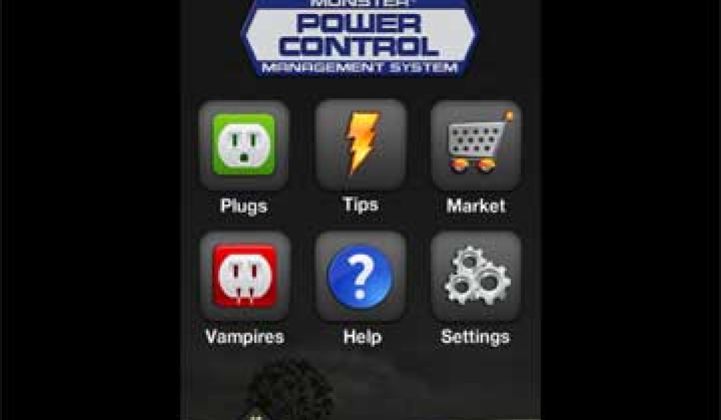We just noted that home energy management companies were making friends to make their way into the mainstream. Chalk up one more with People Power, which has taken its first big step in the long road leading to being embedded into millions of homes.
Instead of working with utilities or putting its products directly on store shelves, the home energy management software company just announced a partnership with Monster, which is best known for its cables and power strips. While some home energy management companies split their focus between distribution channel partners and utilities, People Power has always been focused on working with original equipment manufacturers.
The Monster Power Control app will allow customers who buy a 100 or 300 MC (essentially one- or three-plug outlets) to remotely control any item that is connected.
At a price point of $99.95 for the starter kit, which includes a 100 MC and a portal that plugs into an Ethernet cable, this isn’t necessarily for the refrigerator (where you can’t find the plug) or the toaster oven (which isn’t exactly an energy hog). Additional plugs are $59.95 for a single plug and $99.95 for the three-plug strip.
Gene Wang, founder and CEO of People Power, said that once it is connected, you plug it in and scan the unique QR code on your smart phone and it immediately downloads the app for you. "We’ve created the world’s easiest way to register new devices," said Wang. "A lot of consumers aren’t willing to deal with any IT hassle."
The company is recommending that to start, people just buy the one plug, and then plug a power strip into that. The best bets for energy savings are the home entertainment center and office equipment.
At the Wang household, the entertainment center is set to shut off around 11 p.m. and turn back on at 7 a.m. On weekdays, it shuts back down at 9 a.m. when everyone leaves the home, and turns back on later in the afternoon. Those two settings are saving Wang about $50 per year. (Of course, if you DVR daytime television, this technology is not for you).
The solution might not be cost-effective for many small plug loads, and it certainly isn’t for the tech-challenged. You need to be tech-savvy enough to know what a QR code is and have an app on your smartphone to scan it. Although that may not include your grandmother, if you looked around 2012 CES, where the partnership was announced, a lot of people in attendance would fit these criteria.
Wang shared one figure: about 60 percent of shoppers that make a purchase in Best Buy walk out with a Monster product as well. Even if that figure is larger at big-box stores than at smaller retailers, that’s still a huge number.
But Monster is hardly the only game in town. Best Buy has a new smart home initiative that it will build out with a range of products, and Lowe’s is leveraging AlertMe’s platform for the 'internet of things' in the home. Big-box stores are not the only options either. There’s Tendril, Trilliant, Nexia by Ingersoll Rand, EnergyHub and EcoFactor, just to name a few companies with home energy platforms.
People Power is hoping to build on the early success it has had in 2012 -- and to cash in as OEMs scramble to ensure their devices are connected and controllable. Wang said that People Power recently won two large contracts with electronics manufacturers, one Japanese and one Korean. The company is also part of an energy showcase in Nagasaki that connects solar, electric vehicles and smart plugs and will eventually connect smart water and gas meters.
“We’re talking about more functionality,” Wang said of his company’s plans to expand to other products. “It’s about adding more devices to the ecosystem to provide more energy savings.”



